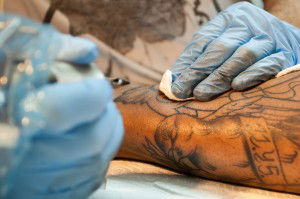
Tattoos can be beautiful and highly symbolic to many, and for many others they can represent a huge regret, especially if the artist does poor work, or you happen to emblazon the name of an ex on your body. Aesthetic principles aside, however, are you aware of the health risks involved with getting inked?
Most of us are aware of the potential dangers of a tattoo artist or parlor not following sterile practices – numerous blood-borne infections, including hepatitis B and C, can be spread this way. Assuming you go to a certified tattoo artist who follows sanitization procedures and uses sterile equipment, however, there are still other risk factors in play.
One of these risk factors is the inks themselves. Many have been found to contain carcinogenic chemicals. For example, many black inks contain the known carcinogen, polycyclic aromatic hydrocarbon, which is also found in cigarette smoke.
Although these chemicals are in stable form when they are tattooed into the skin, it is possible for them to seep deeper into body tissues over time. These carcinogenic particles can be especially dangerous if a tattoo is laser-removed, as the process can de-stabilize the particles and release them into the bloodstream.
Dr. Michi Shinohara, a dermatologist and clinical assistant professor of dermatology at the University of Washington, Seattle, explains that many colored dyes, especially reds and yellows, contain plastic-based pigments that have been largely untested as far as their interactions.
While many people assume that if side effects from a tattoo occur, they will occur right away, this is untrue. Allergic reactions can occur years after the tattoo is done. Tattoos can also in some cases develop bumps and lesions that mimic skin cancer, resulting in expensive biopsies and procedures to diagnose, even if they are not cancerous. Sarcoidosis, a type of inflammatory immune disorder, can can also sometimes occur at the site of a tattoo.
Yet another thing to be aware of when it comes to tattoo health is the possibility of a bacterial infection caused by the ink itself. Contamination can occur during the ink’s manufacturing process, during mixing, or if an ink is used past its expiration date.
One such infection is is known as nontuberculous Mycobacteria (NTM). One species of this bacteria, known as M. chelonae, can lead to joint infections, eye issues, lung disease and organ infection, according to the FDA.
If you have a tattoo, whether it is fresh or years old, be sure to monitor it carefully. If you notice any skin reactions, such as bumps or swelling, see a dermatologist. If you choose to get a new tattoo, make sure to go to a certified tattoo parlor, verify that the artists purchase their inks from a trusted source which monitors manufacturing procedures, and never tattoo over a mole, as this can make it very difficult to determine whether a future skin reaction is cancerous.
 Even when you take all the necessary precautions, however, keep in mind that when you get a tattoo, you are choosing to house largely untested chemical compounds within your skin forever. It is an individual choice as to whether the art is worth the risk.
Even when you take all the necessary precautions, however, keep in mind that when you get a tattoo, you are choosing to house largely untested chemical compounds within your skin forever. It is an individual choice as to whether the art is worth the risk.
-The Alternative Daily
Sources:
http://www.afr.com/p/lifestyle/mens_health/science_unveils_sinister_side_to_I2XyZFBM38Uga0KF3JFEfO
http://www.huffingtonpost.com/michael-yaremchuk-md/tattoos-infection_b_2814444.html
http://www.aad.org/stories-and-news/news-releases/dermatologist-warns-consumers-about-complications-linked-to-newer-tattoo-inks-
http://www.fda.gov/ForConsumers/ConsumerUpdates/ucm316357.htm#3

